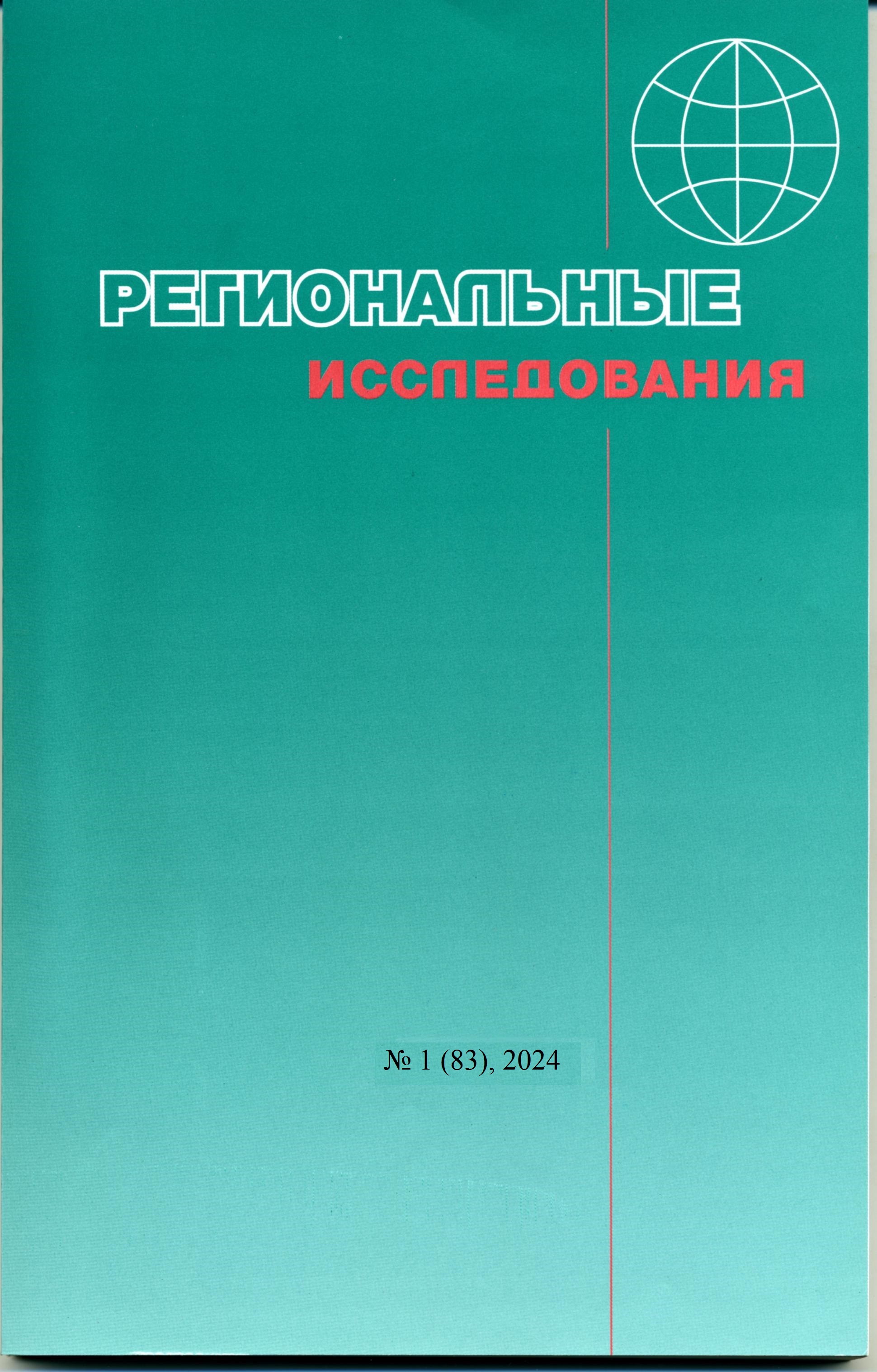Zubarevich N.V., Safronov S.G. Interregional inequality in Russia post-Soviet countries in the XXI century
DOI:
https://doi.org/10.5922/Keywords:
interregional inequality, GRP, investments, personal money income, poverty level, Russia, Kazakhstan, Uzbekistan, BelarusAbstract
The article analyzes the level and dynamics of interregional inequality in Russia, Kazakhstan, Uzbekistan, Belarus and some European countries (in terms of NUTS-2 territorial units) according to available data from official statistics of the CIS countries (1995-2022) and Eurostat (2011–2022). The Gini coefficient, weighted by population and normalized depending on the number of territorial units, was used as the main evaluation parameter. The lower level and stability of interregional inequality in the countries of the European Union and Belarus are associated with a high and more uniform development of the territory and a more stable economic structure. In large post-Soviet countries, the dynamics of interregional inequality are multidirectional; there is no stable trend, which is associated with resource and capital rent in a limited range of regions. In Russia and Uzbekistan since the late 2010s. inequality grew, decreased in Kazakhstan, and was small and stable in Belarus due to the peculiarities of the economic structure and institutional factors of development. Assessments of the influence of the macroeconomic factor on interregional inequality did not provide obvious confirmation of its impact. The impact of the state’s redistribution policy can only be assessed for Russia: it was more noticeable during the crises of 2009 and 2020. Within Russian federal districts, differentiation is lower. High inequality is typical for the extremely heterogeneous Ural Federal District and the Central Federal District, where it has been declining in recent years. In the Far Eastern Federal District, regional differentiation grew, and its gradual increase also occurred inthe regions of the Northwestern Federal District.
Financing
Article is prepared within the state budgetary subject research of geographical faculty of Lomonosov Moscow State University No. 1.17 "Modern dynamics and factors of social and economic development of regions and cities of Russia and neighboring countries".
References
Буфетова А.Н. Поляризация пространственного развития России: камо грядеши? // Мир экономики и управления. 2022. Т. 22. № 1. С. 103–129.
Гагарина Г.Ю., Болотов Р.О. Оценка межрегионального неравенства в Российской Федерации и его декомпозиция с применением индекса Тейла // Федерализм. 2021. № 26 (4). С. 20–34. DOI: 10.21686/2073–1051–2021–4–20–34.
Глущенко К.П. Об оценке межрегионального неравенства // Пространственная экономика. 2015. № 4. С. 39–58.
Глущенко К.П. К вопросу о применении коэффициента Джини и других показателей неравенства // Вопросы статистики. 2016. № 2. С. 71–80.
Гранберг А.Г., Масакова И, Зайцева Ю.С. Валовой региональный продукт как индикатор дифференциации экономического развития регионов // Вопросы статистики. 1998. № 9. С. 3–9.
Дробышевский С., Луговой О., Астафьева Е., Полевой Д., Козловская А., Трунин П., Ледерман М. Факторы экономического роста в регионах РФ. М., 2005. 278 с.
Зайцева Ю.С. Межрегиональная дифференциация в странах БРИК: возможности оценки // Мировая экономика и междунар. отношения. 2010. № 5. С. 44–51. DOI: 10.20542/0131-2227-2010- 5-44-51.
Зубаревич Н.В., Сафронов С.Г. Неравенство социально-экономического развития регионов и городов России 2000-х гг.: рост или снижение? // Общественные науки и современность. 2013. № 6. С. 15–26.
Зубаревич Н.В., Сафронов С.Г. Налогово-бюджетная дифференциация регионов России: масштабы и динамика // Региональные исследования. 2023. № 1. С. 31–41.
Искалиев Д.Ж. Пространственная дифференциация социально-экономического развития Казахстана по оси «центр-периферия» // Географический вестник. 2022. № 3 (62). С. 58–73. DOI: 10.17072/2079-7877-2022-3-58-73.
Камалетдинов А.Ш., Ксенофонтов А.А. Оценка межрегионального неравенства налоговых поступлений // Финансы: теория и практика. 2023. № 27 (1). С. 63–75. DOI: 10.26794/2587-5671- 2023-27-1-63-75.
Коломак Е.А. Эволюция пространственного распределения экономической активности в России // Регион: экономика и социология. 2014. № 3. С. 75–93.
Коломак Е.А. Пространственное развитие России в XXI в. // Пространственная экономика. 2019. Т. 15. № 4. С. 85–106. DOI: 10.14530/se.2019.4.085-106.
Крюков В.А., Коломак Е.А. Пространственное развитие России: основные проблемы и подходы к их преодолению // Научные труды Вольного экон. общества России. 2021. Т. 227. С. 92–114. DOI: 10.38197/2072-2060-2021-227-1-92-114.
Лавровский Б.Л., Шильцин Е.А. Российские регионы: сближение или расслоение? // Экономика и математические методы. 2009. Т. 45. № 2. С. 31–36
Малкина М.Ю. Вклад различных источников в межрегиональное неравенство доходов населения России // Регион: экономика и социология. 2017. № 4 (96). С. 126–150.
Региональные различия и неравенство в Казахстане: тематическое исследование в рамках регионального доклада ПРООН о человеческом развитии на 2016 г. [Электронный ресурс]. URL: http://www.kz.undp.org/content/dam/kazakhstan/docs/research-andpublications/2016/october/Казахстан.pdf (дата обращения: 23.01.2024).
Стратегический план развития Республики Казахстан до 2025 года // Официальный сайт Президента Республики Казахстан. [Электронный ресурс]. URL: https://www.akorda.kz/ru/legal_acts/decrees/ob-utverzhdenii-strategicheskogoplana-razvitiya-respubliki-kazahstan-do-2025-goda-ipriznanii-utrativshimi-silunekotoryh-ukazov-prezidenta (дата обращения: 25.01.2024).
Суспицын С.А. Измерения в пространстве региональных индикаторов: методология, методики, результаты // Регион: экономика и социология. 2014. № 3 (83). С. 3–30.
Суспицын С.А. Макроструктурные и пространственные диспропорции экономики России и ее восточных регионов и направления их снижения // Регион: экономика и социология. 2022. № 3 (115). С. 3–31.
Трейвиш А.И. Город, район, страна и мир: развитие России глазами страноведа. М.: Новый хронограф. 2009. 372 с.
Туманянц К., Арженовский С., Арькова О., Монастырев М., Пичулина И. Неравенство и экономический рост в России: эконометрические оценки зависимостей // Деньги и кредит. 2023. № 2. С. 52–77.
Шаталова О.М., Касаткина Е.В. Социально-экономическое неравенство регионов РФ: вопросы измерения и долгосрочная ретроспективная оценка // Экономические и социальные перемены: факты, тенденции, прогноз. 2022. Т. 15. № 4. С. 74–87. DOI: 10.15838/esc.2022.4.82.5.
Antonov E.V. Territorial concentration of the economy and population in European Union countries and Russia and the role of global cities // Regional Research of Russia. 2020. Vol. 10. № 3. P. 360–372 DOI: 10.1134/S2079970520030028.
Krugman P. Geography and Trade. Cambridge, MA: MIT Press, 1991. 142 p.
Zubarevich N.V., Safronov S.G. Regional inequality in large post-soviet countries // Regional Research of Russia. 2011. Vol. 1. № 1. P. 15–26. DOI: 10.1134/S2079970511010138.

